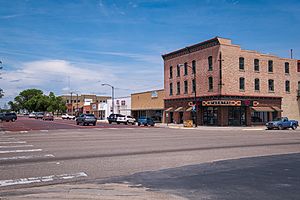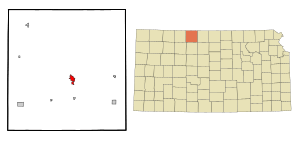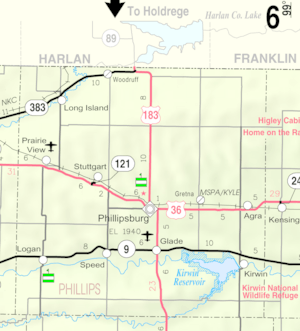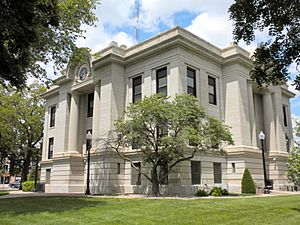Phillipsburg, Kansas facts for kids
Quick facts for kids
Phillipsburg, Kansas
|
|
|---|---|
|
City and County seat
|
|

(2021)
|
|

Location within Phillips County and Kansas
|
|

|
|
| Country | United States |
| State | Kansas |
| County | Phillips |
| Founded | 1872 |
| Incorporated | 1872 |
| Named for | William Phillips |
| Area | |
| • Total | 1.70 sq mi (4.39 km2) |
| • Land | 1.70 sq mi (4.39 km2) |
| • Water | 0.00 sq mi (0.00 km2) |
| Elevation | 1,929 ft (588 m) |
| Population
(2020)
|
|
| • Total | 2,337 |
| • Density | 1,375/sq mi (532.3/km2) |
| Time zone | UTC-6 (CST) |
| • Summer (DST) | UTC-5 (CDT) |
| ZIP code |
67661
|
| Area code | 785 |
| FIPS code | 20-55675 |
| GNIS ID | 485642 |
Phillipsburg is a city in Kansas, United States. It is also the county seat of Phillips County. In 2020, about 2,337 people lived there.
Contents
History of Phillipsburg
Phillipsburg was started in 1872. It became the main town, or county seat, for Phillips County because it was in the middle of the county. The first people moved there in late 1872. The city was named after William A. Phillips, who was a politician and journalist. Phillipsburg officially became a city in 1880.
The first post office opened in Phillipsburg on December 23, 1872. It was first called Phillipsburgh until 1893. Fort Bissel was built in 1872 to protect the area. It was named after John Bissel and closed in 1878. The fort was rebuilt in the city park in 1962.
The first cemetery, Close Cemetery, was started in 1879. It was given to the city in 1889. A railroad line came through Phillipsburg in 1887. In the same year, telephone systems were set up in the city. A big fire almost destroyed the town square in 1906. The current courthouse was built in 1912.
"Kansas' Biggest Rodeo" started in 1929. It is held every year in late July or early August. In 1939, the world's first cooperative oil refinery opened here. It closed in 1992.
Geography and Location
Phillipsburg is in northwestern Kansas. It is on the western edge of the Smoky Hills region. This area is part of the larger Great Plains. The city is in the middle of Phillips County. It is about 20 miles south of the Nebraska border.
Phillipsburg is located on the north side of Deer Creek. This creek flows into the North Fork of the Solomon River. Plotner Creek also flows south along the western side of the city. The city covers about 1.67 square miles (4.33 km2) of land.
Climate in Phillipsburg
Phillipsburg has a climate that can be called either humid subtropical or humid continental. This means it has warm, wet summers and cool, dry winters. January is usually the coldest month. July is the warmest month. May is the month with the most rain.
| Climate data for Phillipsburg, Kansas, 1991–2020 normals, extremes 1893–2010 | |||||||||||||
|---|---|---|---|---|---|---|---|---|---|---|---|---|---|
| Month | Jan | Feb | Mar | Apr | May | Jun | Jul | Aug | Sep | Oct | Nov | Dec | Year |
| Record high °F (°C) | 79 (26) |
86 (30) |
97 (36) |
102 (39) |
106 (41) |
114 (46) |
120 (49) |
117 (47) |
111 (44) |
100 (38) |
88 (31) |
83 (28) |
120 (49) |
| Mean maximum °F (°C) | 63.3 (17.4) |
69.3 (20.7) |
78.2 (25.7) |
88.1 (31.2) |
94.3 (34.6) |
101.2 (38.4) |
105.3 (40.7) |
103.5 (39.7) |
97.8 (36.6) |
90.2 (32.3) |
75.8 (24.3) |
64.1 (17.8) |
107.7 (42.1) |
| Mean daily maximum °F (°C) | 39.8 (4.3) |
43.5 (6.4) |
55.7 (13.2) |
65.2 (18.4) |
75.3 (24.1) |
87.3 (30.7) |
92.5 (33.6) |
90.2 (32.3) |
81.9 (27.7) |
68.0 (20.0) |
53.9 (12.2) |
41.8 (5.4) |
66.3 (19.1) |
| Daily mean °F (°C) | 28.1 (−2.2) |
31.3 (−0.4) |
41.9 (5.5) |
51.1 (10.6) |
62.2 (16.8) |
74.0 (23.3) |
79.3 (26.3) |
77.1 (25.1) |
68.0 (20.0) |
54.2 (12.3) |
40.8 (4.9) |
30.0 (−1.1) |
53.2 (11.8) |
| Mean daily minimum °F (°C) | 16.3 (−8.7) |
19.1 (−7.2) |
28.1 (−2.2) |
37.0 (2.8) |
49.1 (9.5) |
60.7 (15.9) |
66.0 (18.9) |
64.0 (17.8) |
54.1 (12.3) |
40.4 (4.7) |
27.8 (−2.3) |
18.2 (−7.7) |
40.1 (4.5) |
| Mean minimum °F (°C) | −1.6 (−18.7) |
2.7 (−16.3) |
11.8 (−11.2) |
23.4 (−4.8) |
34.6 (1.4) |
47.9 (8.8) |
55.9 (13.3) |
54.3 (12.4) |
39.3 (4.1) |
23.2 (−4.9) |
11.2 (−11.6) |
3.1 (−16.1) |
−6.1 (−21.2) |
| Record low °F (°C) | −22 (−30) |
−22 (−30) |
−16 (−27) |
7 (−14) |
21 (−6) |
37 (3) |
42 (6) |
40 (4) |
25 (−4) |
1 (−17) |
−8 (−22) |
−28 (−33) |
−28 (−33) |
| Average precipitation inches (mm) | 0.49 (12) |
0.86 (22) |
1.52 (39) |
2.44 (62) |
4.34 (110) |
3.02 (77) |
4.04 (103) |
3.13 (80) |
1.69 (43) |
2.09 (53) |
1.08 (27) |
0.93 (24) |
25.63 (651) |
| Average snowfall inches (cm) | 3.4 (8.6) |
6.6 (17) |
1.5 (3.8) |
0.5 (1.3) |
0.0 (0.0) |
0.0 (0.0) |
0.0 (0.0) |
0.0 (0.0) |
0.0 (0.0) |
0.7 (1.8) |
1.1 (2.8) |
3.2 (8.1) |
17.0 (43) |
| Average precipitation days (≥ 0.01 in) | 3.1 | 3.6 | 5.2 | 7.3 | 9.4 | 8.8 | 7.6 | 7.3 | 5.0 | 5.8 | 3.6 | 3.5 | 70.2 |
| Average snowy days (≥ 0.1 in) | 2.0 | 2.6 | 0.8 | 0.3 | 0.0 | 0.0 | 0.0 | 0.0 | 0.0 | 0.2 | 0.7 | 2.1 | 8.7 |
| Source 1: NOAA | |||||||||||||
| Source 2: XMACIS2 | |||||||||||||
Population and People
| Historical population | |||
|---|---|---|---|
| Census | Pop. | %± | |
| 1880 | 309 | — | |
| 1890 | 992 | 221.0% | |
| 1900 | 1,008 | 1.6% | |
| 1910 | 1,302 | 29.2% | |
| 1920 | 1,310 | 0.6% | |
| 1930 | 1,543 | 17.8% | |
| 1940 | 2,109 | 36.7% | |
| 1950 | 2,589 | 22.8% | |
| 1960 | 3,233 | 24.9% | |
| 1970 | 3,241 | 0.2% | |
| 1980 | 3,229 | −0.4% | |
| 1990 | 2,828 | −12.4% | |
| 2000 | 2,668 | −5.7% | |
| 2010 | 2,581 | −3.3% | |
| 2020 | 2,337 | −9.5% | |
| U.S. Decennial Census | |||
Phillipsburg in 2020
In 2020, Phillipsburg had 2,337 people living in 1,040 households. Most of the people (about 93.45%) were white. About 2.82% of the population was Hispanic or Latino.
About 26% of households had children under 18. Many households (44.9%) were married couples. About 38.4% of households were single people living alone. The average household had 2 people. The average family had about 3 people.
The median age in the city was 43 years old. About 23.8% of the people were under 18. About 24.5% were 65 years or older.
Phillipsburg in 2010
In 2010, there were 2,581 people living in Phillipsburg. There were 1,116 households. Most people (96.7%) were white. About 2.6% of the population was Hispanic or Latino.
About 28% of households had children under 18. Many households (48.9%) were married couples. About 34% of households were single people. The average household had 2.25 people.
The median age in the city was 43 years. About 24.7% of residents were under 18. About 21.7% were 65 or older.
Economy and Jobs
Today, TAMKO Building Products is the biggest manufacturer in Phillipsburg. In 2006, a plant that makes ethanol was built on the east side of the city.
Education and Schools
The public schools in Phillipsburg are part of the Phillipsburg USD 325 school district.
The Phillipsburg Panthers high school teams have won state championships:
- 2014 Boys Track & Field - Class 3A
- 2015 Football - Class 2-1A
Culture and Events
The Riverless Festival is held in June. It's a fun event that makes light of the fact that Phillipsburg doesn't have a big river or lake. The festival has craft booths, food stands, and games for kids. Local businesses help support the games and rides.
Phillipsburg also hosts "Kansas' Biggest Rodeo" every year. It usually happens during the first week of August.
Famous People from Phillipsburg
Some well-known people who were born or lived in Phillipsburg include:
- McDill "Huck" Boyd, a newspaper editor and Kansas politician.
- Nelson B. McCormick, who was a U.S. Representative from Kansas.
- Wallace Pratt, a famous geologist.
- Mark Simoneau, a former professional football player in the National Football League.
See also
 In Spanish: Phillipsburg (Kansas) para niños
In Spanish: Phillipsburg (Kansas) para niños


